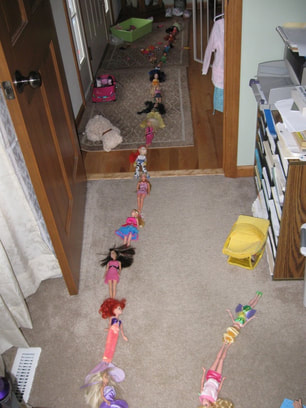Sensory Anchors
A sensory anchor is a behavior or repetitive activity which helps the brain organize, calm, soothe, and achieve or maintain ready state. It is a sensory signal indicating that the child is possibly dysregulated or in need of a dose of a "feel good" sensation that is calming and soothing. It can also be an indicator that the nervous system is on the brink of sensory overload or a sensory meltdown. For our sensory kids, the world can be a scary, unpredictable, disorganizing, and often uncomfortable place...when a child discovers a sensory based activity that feels good to them, they tend to do it over and over. For instance, lining toys up, this can be visually soothing, similar to looking at spinning objects or following a line with the eyes. Toe walking provides proprioceptive feedback, which can be very calming and regulating as well. We all seek out sensory activities which are soothing and regulating, our sensory kids tend to take this to a whole new level.
A sensory anchor helps the child feel grounded, in control of the moment, and a sense of brain organization and regulation. Here are some examples of possible sensory anchors.....
For further information and details on precautions and ideas to help as well as a list of over 200 possible sensory signals and/or sensory anchors, refer to Understanding Your Child's Sensory Signals.
It is very important to respect a sensory anchor as a true sensory need, and allow it when it is not disturbing others or interfering with school work or other daily activities. It is also important to provide alternate sensory tools and strategies to help self-regulate when the specific sensory anchor is simply not feasible. For example : A child at school who loves to flap their hands to self-regulate may need a fidget toy or resistance bands or a compression shirt to help meet this sensory need and to attend to the task at hand.
I do realize that some children perseverate and become fixated on a sensory anchor...and this is when you come into play. When at home encourage and transition to a FUN heavy/hard work play activity, movement activity, or tactile activity which will also help the brain regulate and feel good! Or possibly find an alternative purposeful activity related to the sensory system they are using to anchor (such as using scented markers for a child who enjoying smelling things to regulate, or a labyrinth maze for those who enjoy visual input). The bubble mountain is a great choice for those who make mouth sounds or seek out oral sensory input.
A sensory anchor helps the child feel grounded, in control of the moment, and a sense of brain organization and regulation. Here are some examples of possible sensory anchors.....
- Lining toys/objects up
- Following a line or straight surface with the eyes
- Looking at a spinning object
- Hand flapping
- Toe walking* (refer to Understanding Your Child's Sensory Signals for precautions on this topic)
- Making repetitive mouth sounds
- Chewing on a non-food object
- Smelling objects or a new environment/room
- And many, many more!
For further information and details on precautions and ideas to help as well as a list of over 200 possible sensory signals and/or sensory anchors, refer to Understanding Your Child's Sensory Signals.
It is very important to respect a sensory anchor as a true sensory need, and allow it when it is not disturbing others or interfering with school work or other daily activities. It is also important to provide alternate sensory tools and strategies to help self-regulate when the specific sensory anchor is simply not feasible. For example : A child at school who loves to flap their hands to self-regulate may need a fidget toy or resistance bands or a compression shirt to help meet this sensory need and to attend to the task at hand.
I do realize that some children perseverate and become fixated on a sensory anchor...and this is when you come into play. When at home encourage and transition to a FUN heavy/hard work play activity, movement activity, or tactile activity which will also help the brain regulate and feel good! Or possibly find an alternative purposeful activity related to the sensory system they are using to anchor (such as using scented markers for a child who enjoying smelling things to regulate, or a labyrinth maze for those who enjoy visual input). The bubble mountain is a great choice for those who make mouth sounds or seek out oral sensory input.
